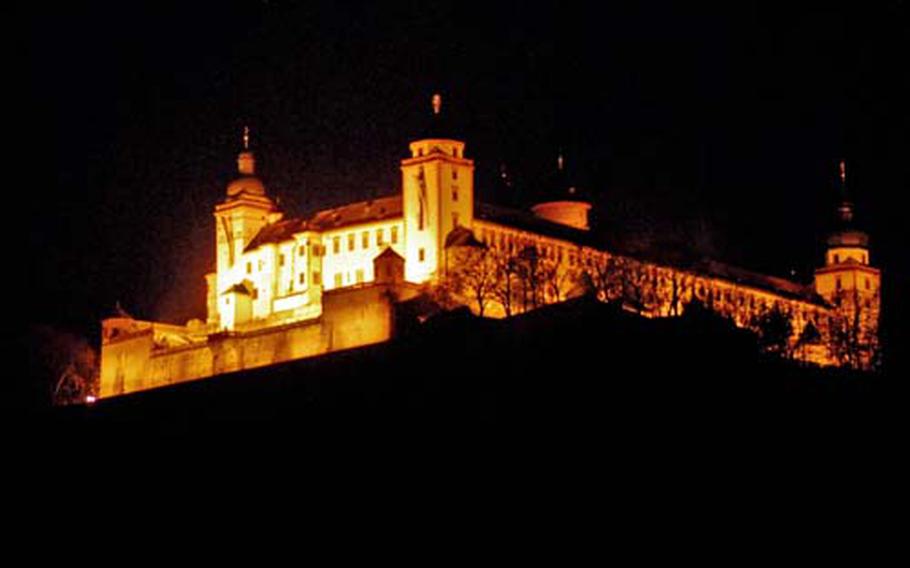
A wing of the Marienberg Fortress, high above the Main River, is home to the museum. (Michael Abrams / S&S)
For a museum dedicated to the art and culture of Germany’s lower Franconian region, the Mainfränkisches Museum in Würzburg could not have a better home.
Housed in a wing of the Marienberg Fortress — perched high on a hill overlooking the city and the Main River — the building’s vaulted rooms add to the museum’s old-time atmosphere.
The exhibits range from the Stone Age to the mid-19th century, and are roughly divided into sections devoted to pre- and early history, paintings, sculptures, and arts and crafts.
The large hall at the entrance, sometimes also used for separate exhibitions, features giant grape presses and other items needed for making wine. Würzburg is, after all, the center of the Franconia wine area, known for its fat-bellied Bocksbeutel bottles, which are also on display at the museum.
Up a floor are the oldest exhibits, reaching from prehistoric times to the early Middle Ages. There are Celtic ceramics, Bronze Age jewelry, medieval glass and two rather grisly exhibits — a cracked Neolithic skull and a necklace made of human teeth. A rare find on display is the burial offerings of a dog framed by two headless horses.
Up another flight of stairs, in a vaulted room, mid- to late-medieval sculptures are on display. Two works worth noting are the late-14th century "Holy Trinity," and the ornate "Death of Mary" from 1490.
Going from room to room, you pass noble tombstones and exquisite paintings. One of them is the fantastic "Martyrdom of St. Kilian and His Disciples" from the 15th century. Also don’t miss "Adam and Eve" by Lucas Cranach the Elder.
The museum is proud of its extensive collection of bozzetti. A bozzetto is a small model an artist uses when making a large sculpture. "The Rape of Proserpine" by Ferdinand Tietz, and "St. Thomas" by Johann Peter Wagner, are two of many fine examples on display.
Follow signs to the Riemenschneidersaal to find the museum’s main attraction: a hall featuring the works of the great German sculptor Tilman Riemenschneider. Its highlight is "Mary in Mourning," from around 1505. A finely sculpted statue of the mother of Christ, you can almost feel her grief over the death of her son in this lifelike work.
Also note "Adam and Eve" from the portal of Mary’s Chapel in downtown Würzburg (the ones framing the door today are copies).
The city has always been a religious center — a prince-bishop once lived in the city’s Residenz palace — so it is not surprising that many of the exhibits have religious themes.
Less spiritual are the 16th-century vintner’s tavern and the traditional festive costumes on display in the museum’s folk-art department on the top floor.
The original museum, along with numerous works of art, was destroyed in World War II. Nonetheless, today’s Mainfränkisches Museum shows an interesting cross section of Franconian arts, crafts and life throughout the ages.
Directions: The Mainfränkisches Museum is in the Marienberg Fortress across the Main River from downtown Würzburg. It is well marked by signs, and there is parking at the fortress. A hike from downtown on marked paths takes about 30 minutes.
Times: The museum is open 10 a.m. to 6 p.m. Tuesday through Sunday from November to March, and 10 a.m. to 5 p.m. the same days from April to October. From now until March 8, there is a special nutcracker exhibit in the museum.
Costs: Admission is 3 euros for adults and 1.50 euros for youths. Children under 14 accompanied by their parents go free.
Food: There is a restaurant at the fortress, but it is open only on weekends during the winter. There are plenty of places to eat in downtown Würzburg.
Information: The museum’s Web site, with an English-language link, iswww.mainfraenkisches-museum.de. A second museum in the east wing of the fortress features the prince-bishop’s apartments and a section on the city’s history. It is open from April to October only.